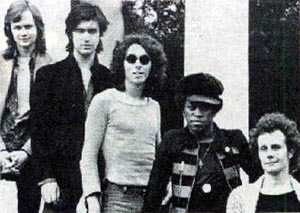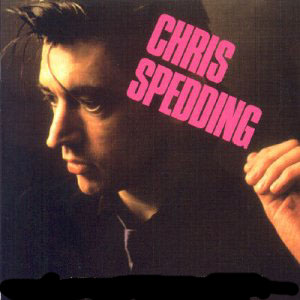RTH: Do you consider yourself successful or do you ever sit back, watch a U2 video and think, “What load of bollocks I can kick the shit outta these guys!”
CS: I think I’m successful. And so are U2. And I probably could kick the shit out of them, one at a time, but they do seem very nice.
RTH: You’ve declared that you’ve had no interest in following the blues-rock guitar style made popular by the likes of Eric Clapton. Did your “anti-Clapton” approach factor into Jack Bruce choosing you to play on his debut solo album?
CS: I don’t know – you would have to ask Jack. I think my decision to adopt an “anti-Clapton” approach was a negative one and not a good move. It only lasted a couple of years and I got over it.
I was never a “Cool Uncle,” more of an embarrassment to them, I think.
RTH: I became exposed to you via Brian Eno’s Here Come the Warm Jets. How did you get involved?
CS: I met Eno & Phil when my band, Sharks, supported Roxy during Eno’s last tour with the band. I met Fripp touring with Centipede.

Sharks, “Doctor Love”
RTH: There are some raw, almost Stones-y recordings of you playing live with Brian Eno floating around. Somewhere I’ve got a live version of “The Paw-Paw Negro Blowtorch”. On an Eno website there’s mention of an unreleased documentary made around these sessions. What is the story behind these recordings and the documentary?
CS: It’s the first I’ve heard of this. I don’t ever remember playing live with Eno. I don’t remember cameras at the studio.
RTH: Is it true you turned down an invitation to join The Rolling Stones following the departure of Mick Taylor?
CS: Sometime in the late spring, early summer of 1975, Jagger called me and asked what I was doing in August. I replied I’d been booked to tour with Roy Harper. Jagger said that was a shame cos the Stones were touring USA at that time. That’s about the substance of the conversation. No offers were made and nothing was “turned down.”

RTH: By the time punk came around, so many of your contemporaries had gone back to Sheffield to make cabinets, but you managed to soldier on and do work with The Vibrators and The Sex Pistols. How did you hook up with these snot nosed punks? We’re you like the Cool Uncle to that crowd?
CS: Chrissie Hynde took me to a Pistols gig at the 100 Club in early 1976. Malcolm McLaren and Vivien Westwood made all my retro ’50s outfits. That was how I got involved. I was never a “Cool Uncle,” more of an embarrassment to them, I think.
RTH: Bryan Ferry’s Let’s Stick Together album is one of my favorite, chunky rock ‘n roll albums. Do you have any particular memories from those sessions? What was it like re-cutting some Roxy Music songs on a Ferry solo album alongside Phil Manzanara? Did Ferry and Manzanara express any feelings about competing with their band’s legacy?
CS: I never worked alongside Phil in the studio. We recorded at different times. I enjoyed that period and thought I did some good work. They were all very talented people at the top of their game.
Next: Once and for all, Chris answers the question on all rock nerds’ minds!


Great work, Sammy! Spedding’s final answer in Dugout Chatter made my day.
I’ll second that. I really enjoyed the interview, but I wanted to wait to comment because I wanted to click on all the cool extras. I like his sound. I’m gonna listen to Here Come the Warm Jets and pay a little extra attention. Thanks, sammy. That was really worthwhile!
His image being sort of a bad boy, it was a pleasure to find Spedding being such a gentleman in the interview.
I wonder if not calling early rock ‘rockabilly’ is an English thing, or who the ‘we’ is in “we never called it rockabilly.”
It’s good to know the secret to his sound (Gibson through a Fender no effects). Spedding is the only current player of a Flying V who comes to mind.
His work on those Island-era John Cale albums was incredible.
I loved his rockabilly answer. I’m not old enough to have been present at the genre’s purported birth, but I do recall its rebirth in the late-70s/early-80s. I find the term limiting and distracting, bringing to mind too many of the totemic items that followers of the Stray Cats cling to dearly. I always thought it was cool that Spedding played a Flying V. He played that stuff like it was ROCK ‘n ROLL, and it was cool to see that suspicion borne out in his comments.
I didn’t know he had a Bad Boy rep. From what Sammy told me, he was a total gentleman throughout the courting process. His story of jamming on Shadows tunes with Fripp was great.
I think one thing calling it rockabilly does is clarify that the music came from country music as much as R&B. The Brits and the revivalists tended to lose sight of rock’s country roots.
Oh, and the ‘bad boy’ comment was meant to imply that I was judging by his Look. I wrote the book on projecting ‘bad boy’ while being a sweetheart inside. Ok, maybe I just read that book.
BigSteve, your country roots comment is spot on. I got turned on to country in the 70’s and found that there was a lot to like (more to hate, but the stuff that feeds off the rock and roll mainline is great). All I ever hear from my classic rock loving friends is that rock came from the blues, and when I bring up the fact that all the studio guitar players from rock’s earliest days were white, country players they completely ignore me and tell me it’s all about Muddy and the Wolf.
I won’t deny that the blues are a huge part of rock n roll, but so is country. I think I tend to lean more towards the rock music that has less blues/more country.